If you make your own bacon, or process your own hogs, you likely know how incredible homemade bacon is. English bacon is slightly different, but easy to make at home if you have a smoker.
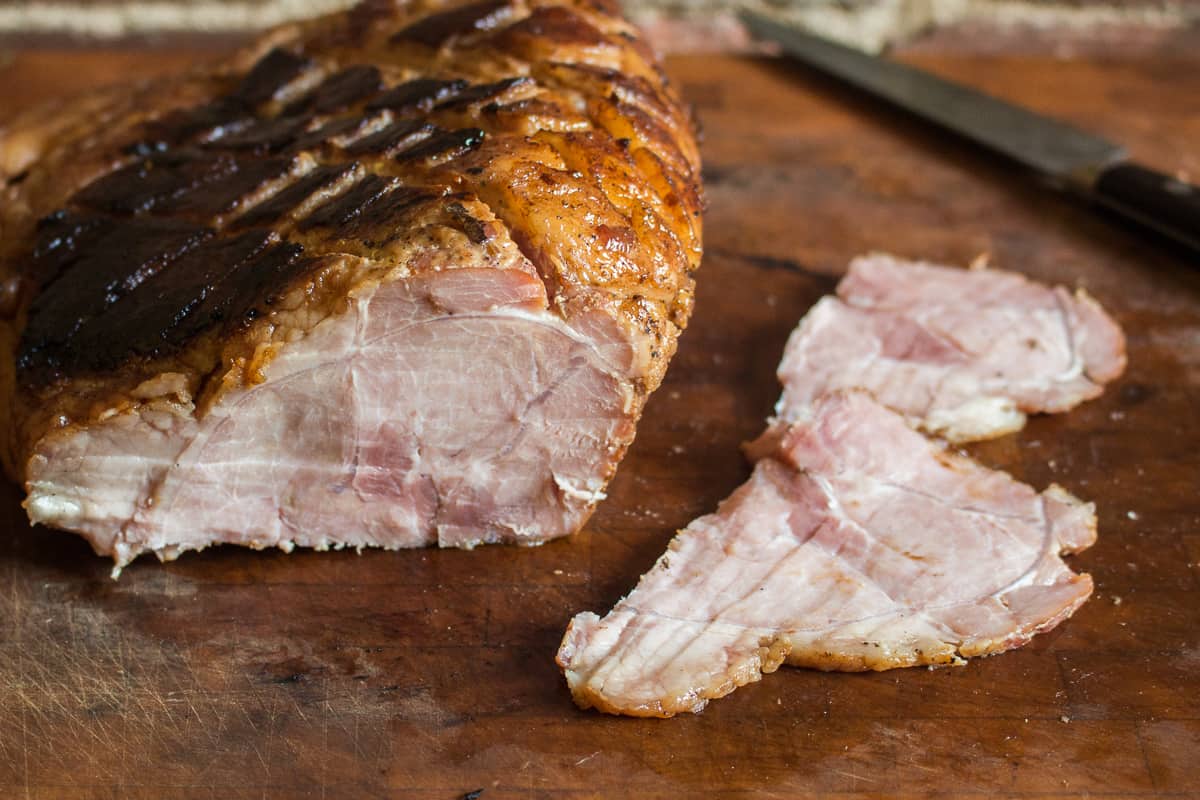
After butchering a few hogs at home, I asked my friends for suggestions on new cuts to make with different parts of the pig. My friend Mathew Normansell, who's British, mentioned British bacon or British back bacon. They might also be known as English rashers.
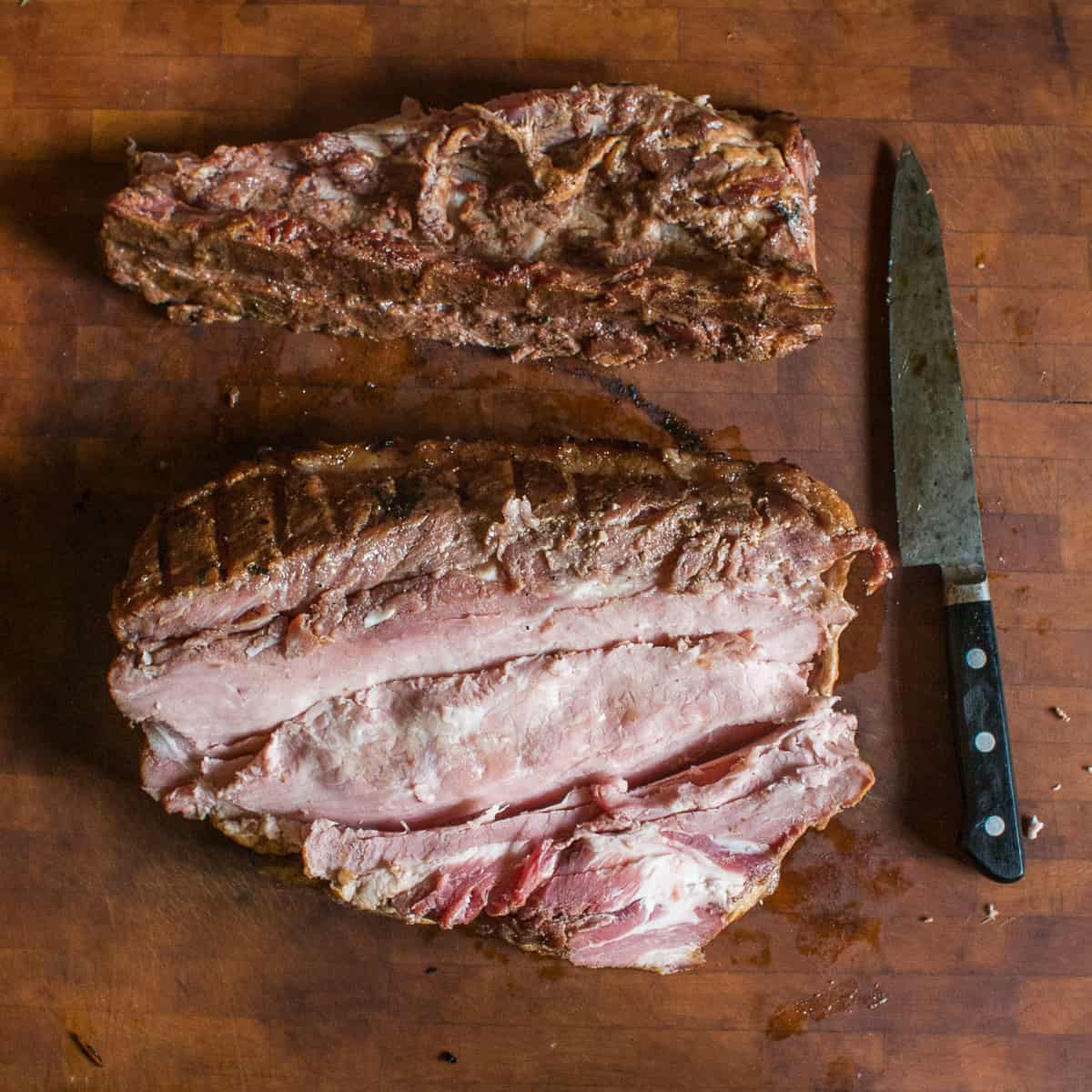
What's English Bacon?
American bacon (called streaky bacon) is made from pork belly. English back bacon is a made from the loin. If you look at pictures it resembles thinly sliced pork chops, and that's exactly what it is.
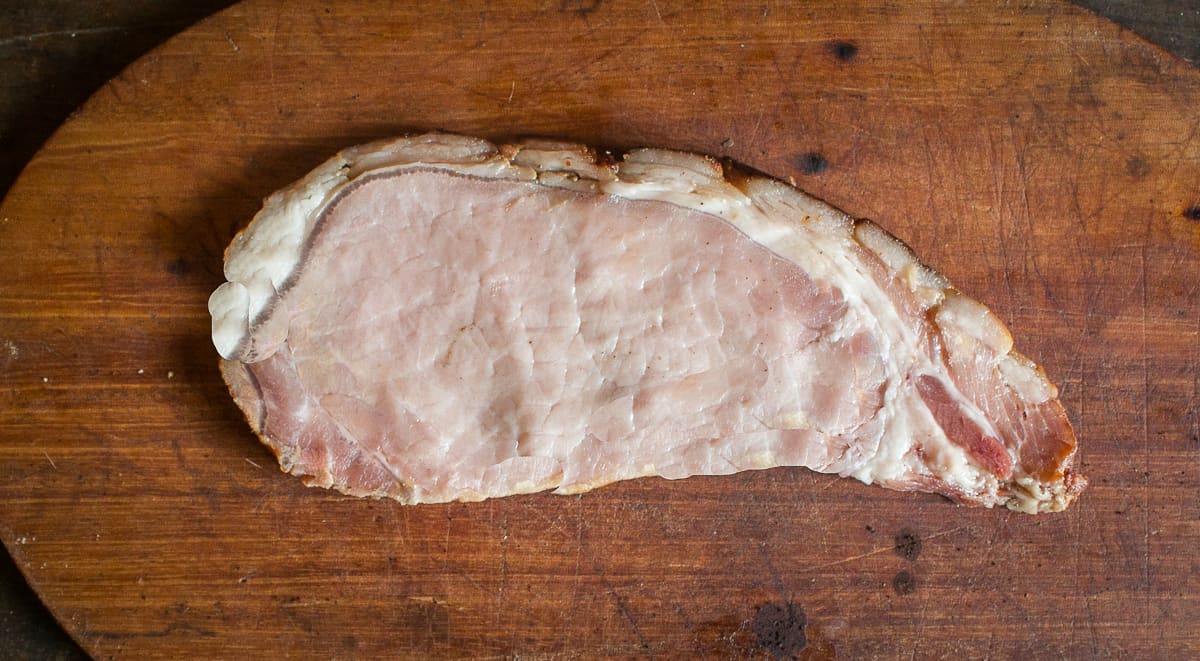
English bacon is a cut from the loin with the fat cap attached. This gives it a nice combination of fat-to meat. It's a bit like Canadian bacon crossed with American bacon.
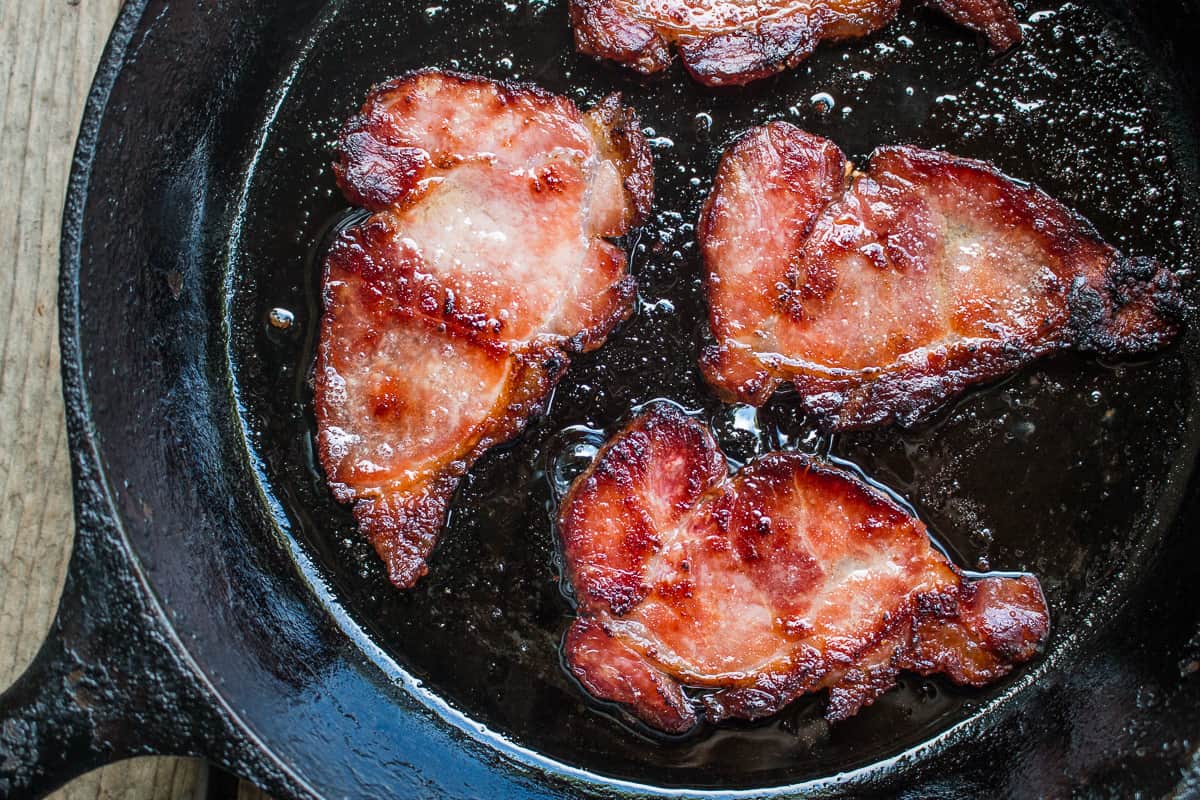
How to Cut English Bacon
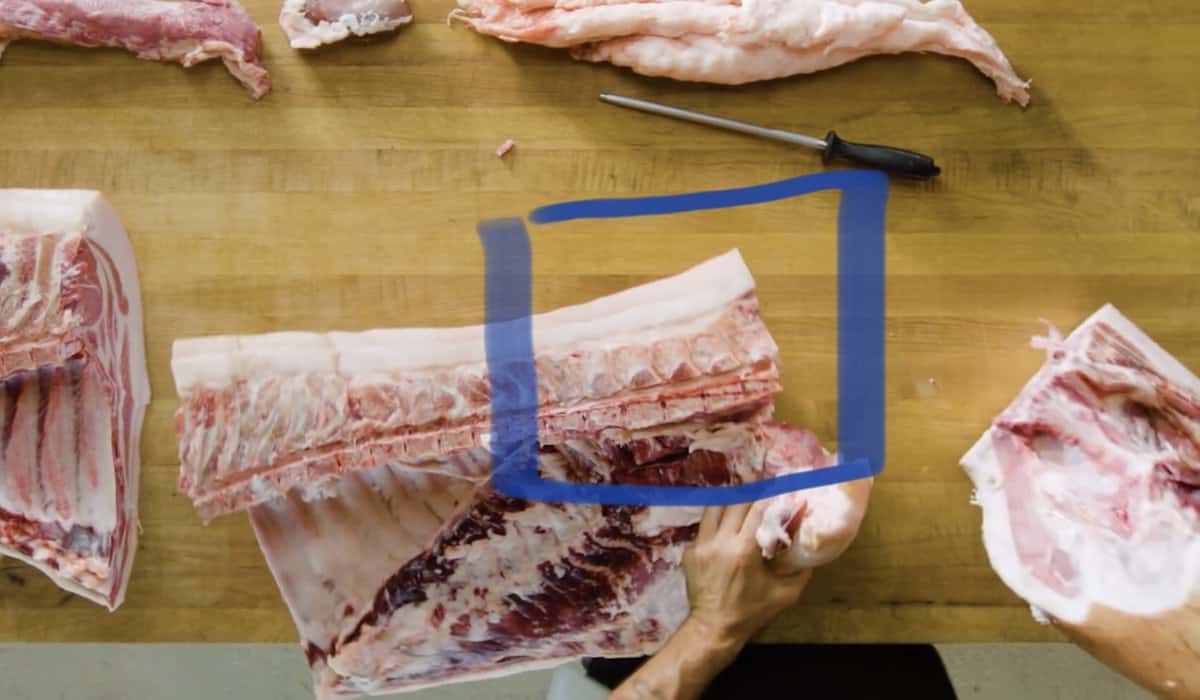
The blue square above shows the rib-less section of the loin that will be your English bacon. If you need a refresher see this video tutorial on whole pig butchery.
- Cut the animal in half through the spine
- Lay the hog half, cut side up on a table
- Remove the shoulders
- Remove the legs
- Remove the belly in one piece, cutting in half with a handsaw for a straight cut
- Take the loin and find where the rib bones end
- Remove the rib-less ⅓ of the loin---this is your English bacon
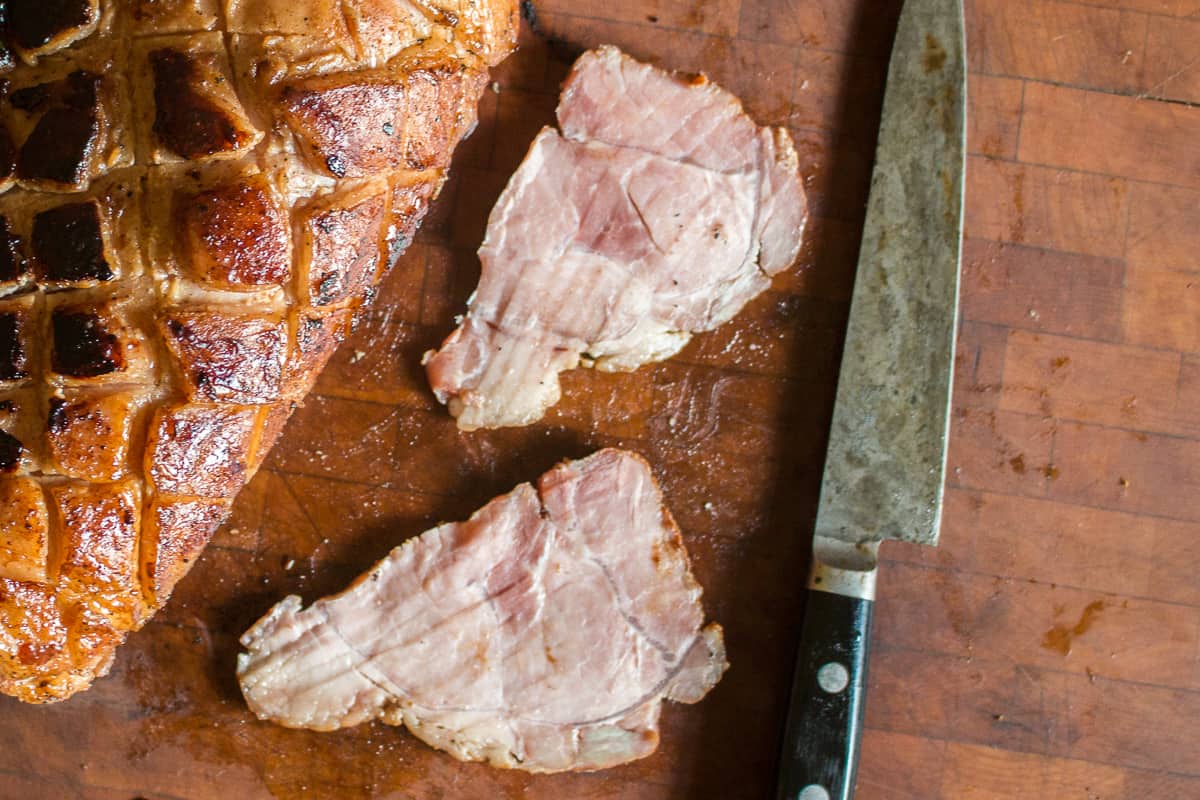
How to Cook English Bacon
Cook UK bacon just like regular bacon, or eat it like ham. English bacon is an important part of a full English breakfast, along with fried tomatoes, beans, eggs, and black pudding. If you don't have time for a whole English breakfast, it's fine on it's own with some eggs and toast, or in a bacon sandwich like a BLT.
Related Posts
English Bacon
Equipment
- Smoker
Ingredients
- 1 rib-less pork loin roast about 3-4 pounds, including the fat cap
- 8 oz brown sugar
- 4 oz kosher salt
- 10 grams or 1.5 teaspoons pink salt sodium nitrite
- ½ teaspoon whole cloves
- ½ teaspoon whole allspice
- ½ teaspoon grated nutmeg
- 1 teaspoon fresh ground black pepper
Instructions
- Combine the spices and grind to a fine powder in a spice grinder, then mix with the salt, pink salt, and sugar.
- Stand the pork roast up so that the fat cap is facing up. Score the fat ¼ inch deep in a cross-hatch pattern, then flip over and cut next to the bone/spine a bit as if you were going to start removing the bone. Follow the bone with a paring knife, revealing an inch or two in, to make it easier for the cure to absorb, and to give you an outline of where to cut to remove the bone when the “bacon” is done smoking.
- Rub the meat liberally with the cure, getting into all the nooks and crannies, then put in a zip loc bag or vacuum seal and refrigerate for 5 days, turning occasionally to distribute the juices.
- After 5 days, remove the pork from the liquid, rinse, pat dry, then refrigerate for at least a few hours, preferably overnight, uncovered, which will help it form a skin that will absorb smoke, known as the pellicle.
- Smoke the loin, fat side up at 225 for 3 hours, or until lightly browned and fully cooked (145-150F)* then cool, cut off the bone, slice, portion, vacuum seal and freeze or refrigerate until needed.

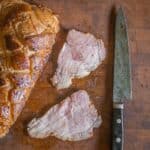
Ted
I'm from Lancashire and was craving a full English. Took a little time for the butcher to order the loin as you describe but this is some good eating. Will be making again!
Alan Bergo
Thanks Ted.
Tony
I am very confused with all this.
I am referring here to both curing and smoking, both of which I have done several times with good results.
However, and in my humble view both 'Britsh' style gammon and bacon are ALWAYS cooked before being eaten, usually fried in a frying pan.
I much prefer my bacon and gammon smoked so then my question is,
In all the recipies I have seen which involve smoking it's mentioned to smoke until the internal temperature is in the region of 145-150F. I think this tempedrature assumes fully cooked but why, since the gammon/bacon is always fried and therefore cooked again ?.
In the case of British style gammon, how to smoke it WITHOUT actually cooking it ?. So it's similar to the 'raw' smoked gammon available at most British supermarkets.
My smoker is the hot type which uses wood and to achieve the 145-150F normally takes 9-13 hours with the cuts of pork I use. Of course this is fine for smoked hams which are meant to be fully cooked but not for bacon and gammon.
Can anyone help ?. A quick mail to tony@familybeale.com would be welcome.
Thanks in advance,
Tony.
Alan Bergo
Hey Tony, you have a few options here. You can cold smoke it, which will leave it raw. Personally, I like it hot smoked to 145F and then warmed up to crisp it a bit before eating. If you smoke it and bring the temp to 145F or so it's also wonderful just sliced after it's cooled and eaten as ham. It's pretty simple, really.
Mark
I hadn't heard of English bacon but here I am making it a second time. After reading comments I can't wait to try with 'brown gravy'. This time I am using a pork butt trimmed just to see if it throws a little ham flavor in. I figure pig + smoke = can't go wrong. Thanks for the fun and tasty recipe!
Alan Bergo
Glad it worked for you Mark. That's great to hear. Now I'm googling brown gravy.
Mark
Excellent little piece of charcuterie
Dave Freeman
Best alternative to Canadian back bacon
H
That is not English bacon or anything close. This is American bacon (cooked through *before* slicing). I'm sure it's delicious but could you edit out the word "English"?
Confusing the two is a potentially dangerous idea as actual English bacon is not edible until cooked and needs handling like the raw meat that it is..
Thank you! Great website 🙂
Alan Bergo
Hendrik, thanks for commenting,
So, another way to look at this post is as a suggestion for homecooks, chefs, and hunters with access to sub-primal cuts to do something different and creative with a cut of meat they may not have thought of before. You're right, English bacon isn't fully cooked, and I note that in the recipe, but saying it isn't anything close to English bacon is a stuffy, puritanical view, and the suggestion of it being dangerous is silly. Trichinosis in American farmed pork coming in at 16 cases a year as of 2020 (via CDC) is a danger from my Grandmother's era, not ours (wild hogs are a different story). Heritage pork is wonderful cooked to 140-145 F, and that temperature is ample to kill and sterilize food from trich (hunters in the U.S. use the method to sterilize bear meat and consume it medium-rare-ish).
Another benefit is bringing awareness to Anglo-saxon cuts and butchery styles. Since I posted this last year, 15K people in the U.S. alone (many of whom probably didn't know there was such a thing as this), have now heard of it. I may take some small creative liberties here and there, but they're well intended. The name stays. 🙂
Robert
I've enjoyed full English breakfasts for years in the UK. When living in Switzerland, I would "smuggle" Greenback and Regular back bacon into Geneva. I enjoyed both regular (smoked). Have also done my own bacon through dry cure and smoke, one cold smoked and once hot smoked. Prefer cold smoked and will do the same with your recipe. Looks very good, thanks.
Anthony walkling
That sounds delicious but that's not how british bacon is made. You almost had it though. British back bacon is cured just like you described but is lightly cold smoked instead of hot smoked. Then we broil it or roast in the oven on lo until the fat crisps turning half way through. Then put on white bread (tomato and lettuce if your posh)ketchup and brown sauce (broadly similar to steak sauce). Man I miss a good english bacon sandwich. I think I'm gonna go ahead and make your recipe but cold smoked
Alan Bergo
In the scheme of things I thought it was close enough. I sent some to my friend from Britain and he was pleased.
Anthony walkling
Oh don't get me wrong I wasnt criticising.just spreading knowledge. I actually just ordered a loin in order to do your recipe.